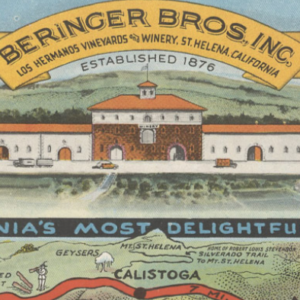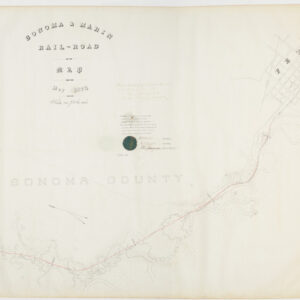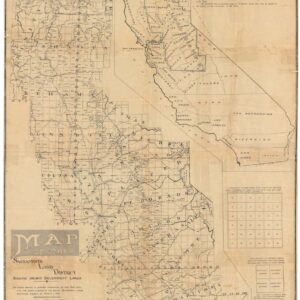A Fine View of the San Francisco Bay and the “Crookedest Railroad in the World.”
Mt. Tamalpais, California / Mt. Tamalpais & Muir Woods Railway.
Out of stock
Description
A charming 1917 bird’s eye view of the Bay Area, looking out over Mt. Tamalpais and Muir Woods. The view and accompanying brochure were meant to advertise the Mt. Tamalpais & Muir Woods Railway, a popular route at the time known as the “Crookedest Railroad in the World” for several tight switchbacks that were employed to rapidly ascend the mountain.
The view is oriented towards the southeast, looking out over the southern part of Marin County. Aside from Mt. Tamalpais and Muir Woods, other local landmarks and towns are recognizable, such as Sausalito, Point Bonita, and San Quentin (State) Prison. Other features are less obvious to a modern viewer, including the Belvedere Reservoir (later abandoned) and Willow Camp, in the foreground, later renamed Stinson Beach.
Beyond Marin, cities, mountains, and railways around the Bay Area are illustrated and labelled, with the more distant peaks of Mt. Shasta and Mt. Lassen appearing in the distance. At bottom-left, a box touts the sunshine and magnificent views from the mountain and provides a table of distances “as the crow flies” to various points seen in the view.
The Mount Tamalpais and Muir Woods Railway
Beginning operations in 1896 from Mill Valley, the scenic railway quickly became a popular attraction for San Francisco residents seeking to escape the city and enjoy the fine views and crisp air afforded by Mt. Tamalpais – a ferry ride across the Bay and a short train trip from Sausalito to Mill Valley were all that separated the city from a ride up the mountain. Residents of the fast-growing towns of Marin County could similarly access the railway with relative ease. Atypically for railroads, but somewhat more common among mountain trains, a geared steam locomotives pushed passenger cars up the mountain from the rear of the train rather than pulling them from the front.
Aside from its scenery, the railway was renowned for its steep grade, many curves (switchbacks), and for its ‘gravity cars,’ which carefully coasted passengers down the mountain using only the force of gravity and a steady set of brakes. The “double bow knot,” where the line quickly doubled back five times at a steep grade, was perhaps the most prominent display of the railway’s audacious ascent. Clever planning, including a hotel, post office, and restaurant at the “Tavern of Tamalpais,” where the train terminated, as well as other amenities along the way, such as the West Point Inn (still in operation today), made the railway even more attractive to visitors. In 1907, a spur line to Redwood Canyon, soon afterwards designated the Muir Woods National Monument, was also a resounding success.
Despite its early popularity, the railway quickly declined in the late 1920s due to a series of setbacks. The opening of an auto road up Mt. Tamalpais in 1925 undercut the railway’s monopoly on passenger transit on the mountain. Then, in 1929, a wildfire nearly burned down the depot in Mill Valley where the train originated and caused extensive damage to the mountainside, reducing its appeal, and to the rail line itself. Soon afterwards, the Great Depression reduced demand for tourism, causing the railway to close in the summer of 1930.
Though the Mount Tamalpais and Muir Woods Railway did not survive, the railroad grade remains as a popular hiking trail. Near the mountain’s summit, adjacent to a large parking lot, a Gravity Car Barn is used today as a museum dedicated to the railway, with a gravity car displayed on a short track just outside the barn.
Census
This view appeared in a 1917 booklet published by the railway itself. It is quite rare, being listed in the OCLC (20423955) among the holdings of six institutions: the University of California Berkeley, the University of California Davis, the the University of California Santa Barbara, San Diego State University, the Wisconsin Historical Society, and Yale University.
Cartographer(s):
The Mount Tamalpais & Muir Woods Railway, also known as the Mt. Tamalpais Scenic Railway, was a historic railroad in Marin County, California, near San Francisco. It was an early 20th-century narrow-gauge railroad that operated from 1896 to 1930.
The railway was primarily a tourist attraction, offering visitors a scenic and leisurely way to reach the summit of Mount Tamalpais, which is the highest peak in the Marin Hills. The line began at the town of Mill Valley and ascended through picturesque redwood forests and scenic landscapes to the summit, where tourists could enjoy panoramic views of the San Francisco Bay Area.
Condition Description
Folding brochure. Wear along fold line. 16 unnumbered pages, staple bound.
References



